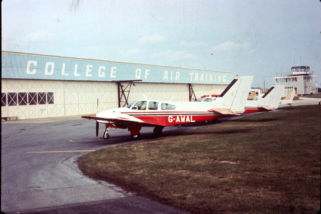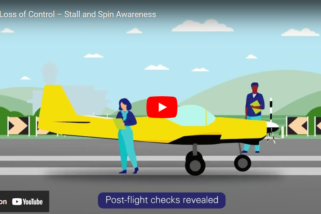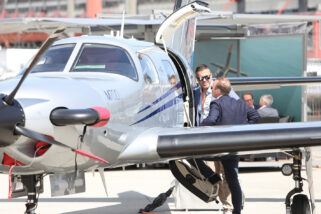In a highly unusual move, the UK Air Accident Investigation Branch (AAIB) has urged the CAA to re-think how engine failures are taught and emergency procedures practiced. The AAIB action comes after two recent accidents involving partial engine failures in the take-off phase of flight. Their investigation into these serious accidents has prompted the AAIB to call for a change in UK flight training syllabi to cover situation of partial engine failure; in addition to the current requirement to practice, and be examined on, procedures for dealing with total engine failure.
Two recent accidents in particular have pressed the AAIB to act. Last June, a Rogers Sky Prince (a home-built version of the Jodel D150 Mascaret) being flown by a Class Rating Instructor (CRI) with over 700 hours experience, was taking-off from Goodwood airfield when it suffered a partial engine failure. Witnesses saw the aircraft struggling to climb and appearing to be slower and lower than for a normal take-off. It seems that the aircraft then stalled and the aircraft crashed about 500 metres outside the airfield boundary, fatally injuring both occupants. Less than three months later, a Grumman AA-5 was taking off at Teesside airport when a mechanical breakage caused a partial engine failure at around 120ft over the runway. The pilot of 1600 hours experience elected to turn back to land in the reciprocal runway direction but in the words of the accident report: “At approximately 60ft agl, the left bank angle suddenly increased, and the aircraft descended rapidly, striking the ground 67 seconds after becoming airborne.” All three occupants were seriously injured. Both of these accidents are reported in more detail in the ‘Safety Matters’ section of this issue of FTN.
In their investigations into these two accidents, the AAIB have defined partial engine power loss as: “A situation where an engine provides less power than commanded by the pilot, but more power than idle thrust.” The AAIB go on to note that in the ten years 2011 to 2021 the AAIB investigated 16 accidents involving partial loss of engine power. 15 fatalities resulted from those 16 accidents as well as nine serious or life-threatening injuries. Two of the accidents resulted in no injuries, both as a result of flying the aircraft under control to a successful forced landing or ditching. The AAIB also note that in the 10-year period there were five attempted ‘turnbacks’, all of which resulted in fatalities or injuries.
At present the EASA, UK and FAA syllabi for flying single-engine aircraft make no reference to partial power failure, and in practice two specific engine failure scenarios are taught and practiced:
- Engine Failure After Take-Off (EFATO) – a complete power failure, typically at around 300ft agl after take-off.
- Practice Forced Landing (PFL) – a complete power failure from cruising flight, typically commencing at around 2,500ft above the surface.
Likewise, the Flight Examiner (FE) handbooks produced by the CAA and EASA make no reference to examining a partial power failure scenario in single engine aircraft. As one experienced flight instructor told FTN: “If the primary purpose of flight training is for the student to pass a test, then limiting the teaching and practice of emergency procedures to those they are going to be examined on makes perfect sense. Of course, if we actually want to teach people to fly to the best of their ability, and to become safer pilots, a more imaginative approach to abnormal and emergency situations is called for.”
Although the CAA does not specifically include partial engine failure in its training syllabi, its publication The Skyway Code does address the issue. In its ‘Emergency’ section it advises the following actions in the event of engine failure:
- Know your best glide speed and procedures for your aircraft.
- Particularly at low level, focus on maintaining speed and control. Provided you keep the aircraft at flying speed and under control, engine failures are unlikely to be fatal.
- If a failure happens shortly after take-off, landing ahead is safer than attempting to turn back. Assess the area immediately in front of you and pick the place that is likely to cause the least damage.
The Skyway Code then goes on to address the specific issue of partial engine failure:
- Partial engine failures can confuse the decision-making process. Assess whether the failure is likely to become worse – for example if rapidly losing oil pressure, the engine may not run for much longer. Take a positive decision to either put down in a field or continue to an aerodrome, depending on your judgement of the problem.
…the issue of training for a partial engine failure has been addressed in Australia by the Australian Transport Safety Bureau
As the AAIB point-out, the issue of training for a partial engine failure has also been addressed in Australia by the Australian Transport Safety Bureau (ATSB). In 2013, the ATSB published a safety leaflet entitled ‘Avoidable Accidents No. 3. Managing partial power loss after take-off in single-engine aircraft’. This publication noted that according to ATSB safety data, during and after take-off, a partial power loss is three times more likely than a complete engine failure. Furthermore, the ATSB had recorded nine fatal accidents from 2000 to 2010 as a result of a response to a partial power loss, compared with no fatal accidents where the engine failed completely. The Australian PPL syllabus does contain a section for teaching partial power loss, but only in the context of a ‘forced landing’ scenario, and not as an exercise to be practiced immediately after take-off.
The ATSB leaflet recommends three key actions to prevent or manage a partial engine failure after take-off using the following strategies:
- pre-flight decision making and planning for emergencies and abnormal situations for the particular aerodrome;
- conducting a thorough pre-flight and engine ground run to reduce the risk of a partial power loss occurring;
- taking positive action and maintaining aircraft control either when turning back to the aerodrome or conducting a forced landing until on the ground, while being aware of flare energy and aircraft stall speeds.
The ATSB also recommends that pilots make a ‘self-brief’ before every take-off. Although this is common in multi-engine and commercial flying, it is still almost unknown in private, single-engine operations. Such a self-brief might comprise of a review of the take-off situation (runway length, weather, obstructions and possible landing areas) and probable actions in the event of an emergency. There is a precedent for this form of self-briefing in the gliding world, where the British Gliding Association (BGA) publish a recommended pre-take-off checklist including an item entitled ‘Eventualities’. This item invites the pilot to consider what actions to take in the event of an emergency or abnormal situation. The BGA instructor manual recommends the following approach to considering ‘Eventualities’:
Its main focus is as a memory jogger, so it can stand for ‘Engage brain’. In practice the check might be a very brief resume of points related to the launch, containing some reference on what to do in the event of a cable break, and a reminder of the speeds required to be able to cope with the eventuality – for example, what is the minimum speed required before we can start to manoeuvre, should we need to. Likewise, if we’re landing straight ahead, what’s a sensible approach speed.
The BGA Instructor Manual also offers the following advice regarding a failure during aerotowing, which is closest to a powered-aircraft take-off:
During the early stages of an aerotow, safe landing options are limited. Unlike wire launches, there can be a period when it isn’t possible to land safely within the airfield boundaries. In the event, there is little time to think about the options or to search for places to go, so it’s important to identify suitable off-field emergency landing areas during the tow, until height and position are such that a safe return can be made to the site.
There is no doubt that teaching and practicing partial engine failures presents a challenging situation to the instructor. Whilst practising a partial engine failure from, say, 2,500ft is likely to present few new hazards to the flight, practising a partial engine failure at, say, 300ft has the potential to significantly increase risk. It is debateable how far the ‘partial engine failure after take-off’ scenario can be practised by a student pilot; or whether a suitable ground briefing, demonstration only by an instructor, and/or practise in a flight simulator, can adequately cover this possibility. In any event, the evidence suggests that a re-think about how engine failure scenarios are taught and practised in single-engine aircraft is well overdue.
FTN asked the CAA is they were actively considering the AAIB’s recommendations. At the time of going to print, the CAA had been unable to respond. We hope to hear back from the Authority ahead of the August edition.






